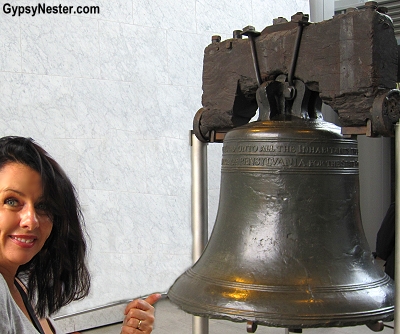
We popped up out of the 5th Street Subway Station and found ourselves right in the heart of history, directly in front of Independence Hall.
Truly the birthplace of our republic, this is where both the Declaration of Independence and the Constitution were deliberated and approved.
We felt it all around us, inch for inch this must be the most historic ground in America.

Built in 1753 to house the colonial legislature of Pennsylvania, the hall became the meeting place for the Second Continental Congress in 1775, then the site of the Constitutional Convention in 1787.
Prior to the ratification of the Constitution there was no official United States capital (or capitol, for that matter) but Philadelphia, and this building, certainly served the purpose.

Once the nation was officially formed, New York City was named the capital.
Not everyone was on board with that idea, so debate to decide a permanent site carried on.
Congress finally settled on Washington, DC, but while the new city was being built Philly, once again, served as the capital city. This time officially.
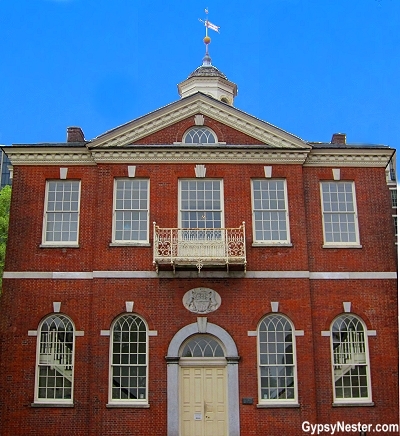
For those few years the building right next to Independence Hall, Congress Hall, housed the government, with the House of Representatives meeting on the main floor, and the Senate upstairs.
This was also the site of two presidential inaugurations, George Washington for his second term, and John Adams.
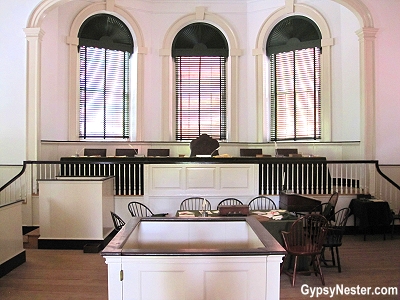
As we made our way to the building on the other side of Independence Hall, the Old City Hall, it hit us that we were truly walking in the footprints of the founding fathers.
No doubt many of our democracy designing dads made this same trip when the city hall housed the Supreme Court during Philadelphia’s time as the capital city. As part of the Independence National Historical Park, the Park Service has completely restored the interior of the old hall.
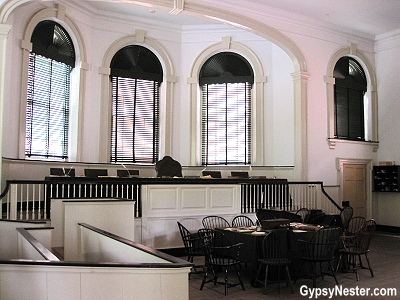
May it please the court, we found the jury box, witness stand, and judicial bench guilty of looking just as they would have when statesman, patriot, and first Chief Justice of the United States John Jay called the court to order in 1791.
Let Freedom Ring!
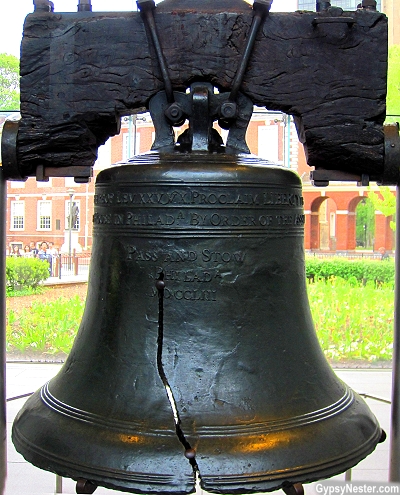
Directly across from the Independence Hall Complex is The Liberty Bell Center.
While waiting in line to see the bell we pondered just how some things become so iconic. It did toll from the tower of Independence Hall, but actually played a very small part in history.
In fact, the story of it ringing out the news of declaring independence on July 4, 1776 is most likely false, since the declaration wasn’t read in public until July 8. Yet the bell has captured the hearts of Americans for over one hundred and fifty years.
The bell did ring out many special occasions through the years, and sustained a nasty crack at some point along the way, but much of its celebrity seems to stem from an 1847 story in the Saturday Review by George Lippard.
He penned a legend about an aged bellman waiting by the bell on July 4, 1776, and a young boy who appeared with instructions to ring the bell proclaiming the declaration.
Within a few years, the fable had been accepted as fact, and soon began to appear in textbooks.
But what is history without a good tale or two?
With this fame the bell became an icon, and toured the country after the Civil War. All the travel, and souvenir hunters picking at it, made the prominent crack worse, so the National Park Service took control in 1948, and finally placed it in The Liberty Bell Center in 2003.
That brings up another legend, how did the bell get cracked? Truth is no one seems to know for sure, but we don’t feel like the symbolism of the bell is diminished one bit. Let freedom ring!
Not Everyone was Free
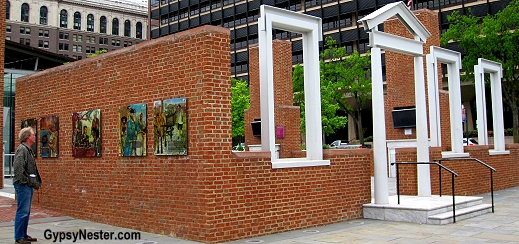
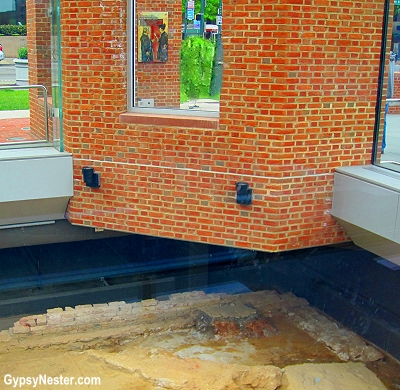
In front of The Liberty Bell Center we came upon a relatively new discovery, The President’s House, which opened in 2010.
While it was known that a house where Presidents Washington and Adams had lived stood on this site until 1832, it wasn’t until 2000, while excavating for the new Liberty Bell Center, that the foundation was uncovered.

When it was revealed that the exposed ruins were part of the slave quarters, a door was opened for discussion of a topic that had been long avoided, the fact that many of our founding fathers were slave holders.

The memorial, President’s House: Freedom and Slavery in the Making of a New Nation, addresses the subject like this:
If we are to understand how a nation founded on the principle that “all men are created equal” could also somehow embrace and justify slavery, we must examine the context and effect of this contradiction on the lives of Americans of every race and condition.
Eating Like a Patriot
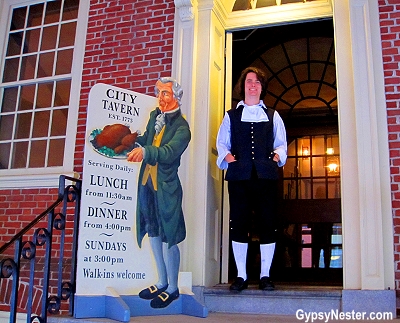
With that food for thought filling our heads, we were ready for a repast.
To indulge that notion, and to get fully immersed in the colonial spirit, we headed to an interesting addition to the Independence National Historical Park, the nearby City Tavern.

The original structure was partially destroyed by a fire, perhaps of suspicious origin according to our server, in 1834 and then demolished in 1854.
But a perfect replica of the historic building was built and re-opened in 1976 for the United States Bicentennial.
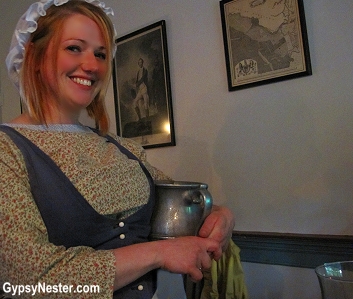
As the seeds of the revolution were sprouting, the City Tavern was certainly at the center of it all.
John Adams called it “the most genteel tavern in America” while visiting Philadelphia for the First Continental Congress, Paul Revere rode here to proclaim the news that the British had closed the port of Boston, and Thomas Jefferson kept an open tab while writing the Declaration of Independence.
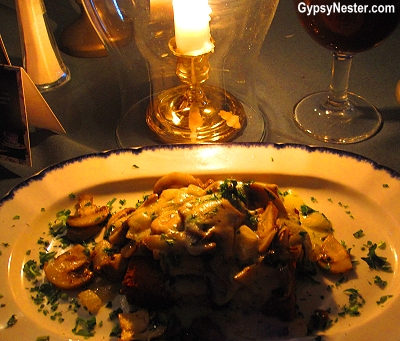
Being a tavern we felt a tankard of ale was in order, how opportune that the City Tavern has Ales of The Revolution on tap.
These are brewed with the very recipes used by George Washington, Thomas Jefferson, and Benjamin Franklin. We choose Jefferson’s 1774 Tavern Ale, and Franklin’s Poor Richard’s Tavern Spruce.
Move over Sam Adams, it seems many a founding father knew a thing or two about beer. As Franklin said, it proves God loves us and wants us to be happy. Cheers!

We were excited to sample truly typical colonial fare, and with owner and executive chef Walter Staib using many authentic 18th-century recipes, including Martha Washington’s Turkey Pot Pie, we were not disappointed.
The menu also mentioned an intriguing story about Benjamin Franklin. It seems that he introduced tofu to North America in a 1770 letter to his friend, the renowned botanist John Bartram, so we ordered that too.
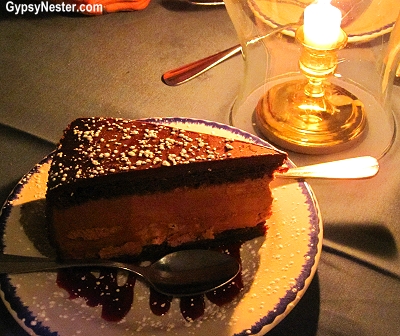
It is hard to imagine that the colonists ate this well, but if the portraits of Ben Franklin accurately portray his paunch, we have reason to believe they did.
Speaking of old Ben, there are plenty of tributes to Mr. Franklin throughout Philly, and we intended to see most all of them the next day. So we formed a plan that was all about the Benjamins.
Back to Ben
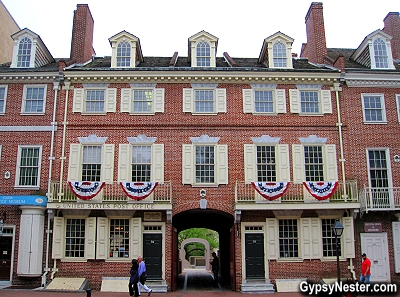
Our initiation into all things Ben began at Franklin Court.
This was not only where Franklin lived, but also where he worked. He owned all of the buildings surrounding the courtyard, one of which served as a post office, and another as his print shop.
Both are still operating, the post office in its official capacity, and the print shop as a reproduction run by the National Park Service.
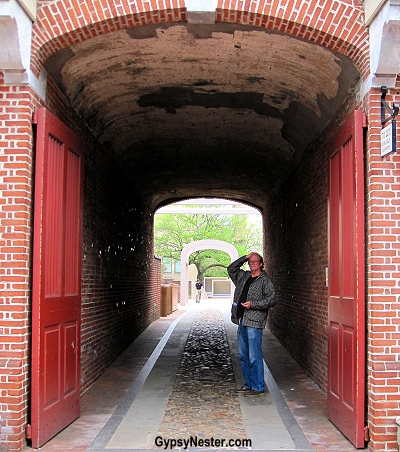
The house where Franklin lived from 1763 until his death in 1790 stood in the center of the courtyard, but has been gone for two hundred years.
A steel frame “ghost house” showing the location was built for the bicentennial in 1976. Beneath that outline we found several viewing portals where remnants of the Franklin home can be seen below ground level.
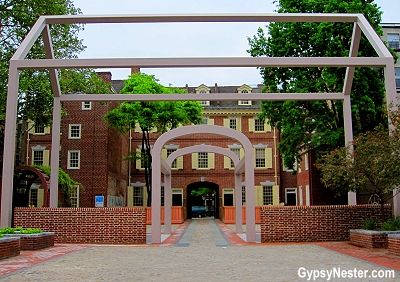
The site was excavated beginning in 1953, and continuing up to just before the bicentennial celebrations.
Viewing stands over the excavations were installed that show foundations, walls, and even one of Franklin’s privy pits.
We had no idea that we would be getting so personal with one of the founding fathers!
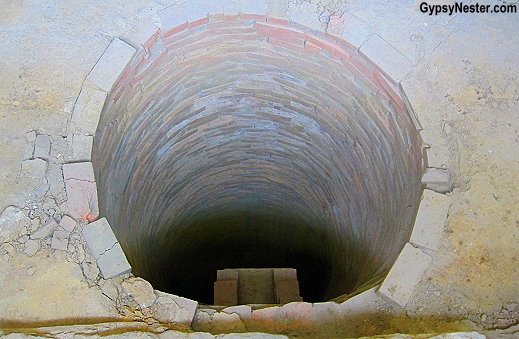
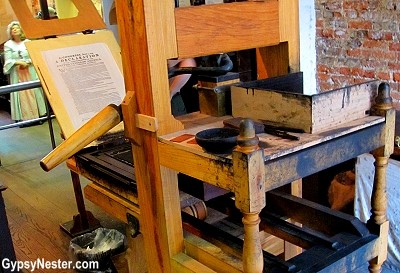 When we entered the print shop a ranger was printing up a copy of The Declaration of Independence as a demonstration for a group of school kids.
When we entered the print shop a ranger was printing up a copy of The Declaration of Independence as a demonstration for a group of school kids.
Eavesdropping on the field trip was almost like having our own tour guide. The entire process, including the press and type setting, is just as it would have been when Franklin was printing newspapers here in revolutionary times.
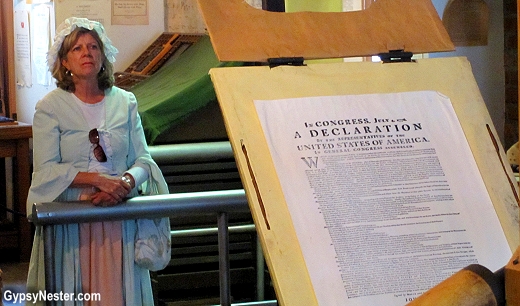
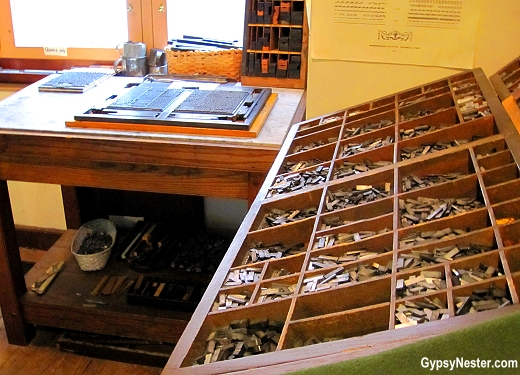
Mr. Franklin realized that the sharing of information would be essential if our fledgling country was to unite, so he began mailing newspapers throughout the colonies to keep everyone on the same page, so to speak.
Perhaps that is why he opened a post office next door.
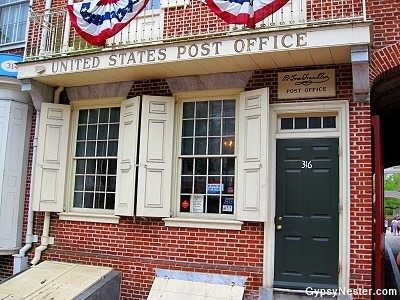 The B. Free Franklin Post Office looks much like it would have when Franklin used it as the first Postmaster General in 1775.
The B. Free Franklin Post Office looks much like it would have when Franklin used it as the first Postmaster General in 1775.
The clerks were happy to explain the history to us, and included the fun fact that this is the only post office in the United States that does not fly the stars and stripes.
Sounds strange, but it is in recognition of the fact that it was opened under British colonial rule, so the United States didn’t have a flag yet.
Betsy’s Place
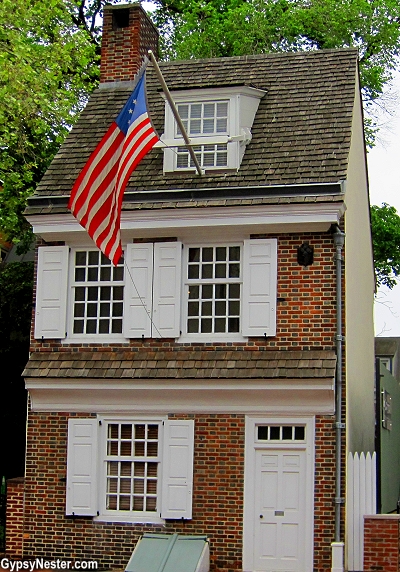
Speaking of flags, the Betsy Ross house was just up the street and, even though this particular site is of dubious historic value at best, we felt we should see it.
We hate to be bursters of bubbles, but not only is the legend of Betsy sewing the first flag most likely false, there is also serious doubt as to whether she ever even lived in this house.
Pop!

A very nice local gentleman tipped us off to something nearby that is a little less famous, but a lot more authentic, that sounded right up our alley… Elfreth’s Alley.
Named after Jeremiah Elfreth, a colonial blacksmith, this is considered the nation’s oldest residential street, and it has been amazingly preserved.
A rare surviving glimpse into life on a 18th-century working-class street. What a great tip!
Carpenters’ Hall
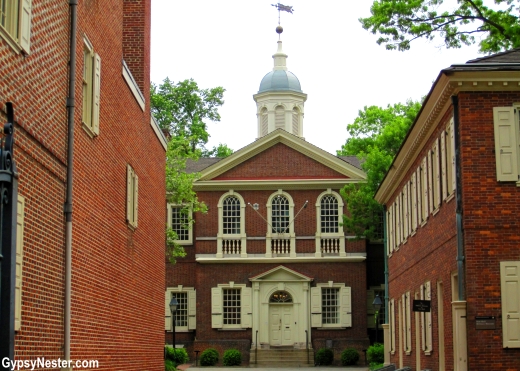
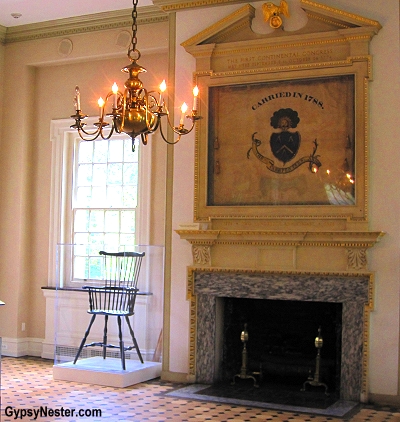
Perusing our map we discovered that we had missed Carpenters’ Hall, so we backtracked a bit to see it.
In a way this could be called America’s first capitol building, since the First Continental Congress met in the hall in September and October of 1774.
Later it served as a hospital for both British and American troops during the Revolutionary War, and as home to Benjamin Franklin’s Library Company, The American Philosophical Society, and the First and Second Banks of the United States.
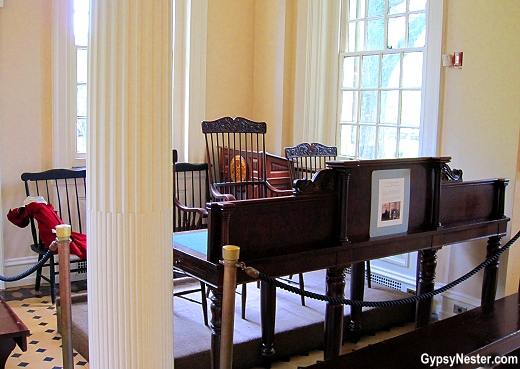
Ben Franklin’s Final Resting Place
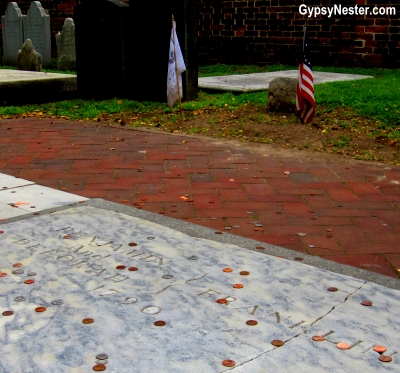
Our final stop was Benjamin Franklin’s grave. Though he was originally from Boston, Franklin had such impact on Philadelphia that it is very fitting for his final resting place to be in The City of Brotherly Love.
He is laid to rest next to his common-law wife of forty-four years, Deborah, in the Christ Church Burial Ground. We thought it was odd that the tomb was covered with pennies, but learned they are from a Philadelphia tradition that is supposed to bring the penny-tosser good luck.
We certainly felt like we had plenty of good fortune during our adventures in Philly – even without tossing a penny.
David & Veronica, GypsyNester.com
Thanks to Amtrak for providing the train travel portion of this adventure through Boston, Philadelphia, New York, and Washington, DC! As always, all opinions are our own.



a knockout post.
great site!
Thanks!
What can be better than this wonderful website and a cup of coffee in the evening!
Thank you very much for the information provided
I’m very impressed
Wow! Nice webpage 😉
I love what you guys tend to be up too. This sort of clever work and reporting!
Keep up the superb works guys I’ve added you guys to my personal blogroll.
Feel free to visit my blog post exam (https://cutt.ly/)
Fantastic posts. Thank you!
I don’t usually comment but I gotta admit thank you for the post on this special one
:D.
Thanks, it’s very informative
Thank you for the terrific post
Truly one of our favorite destinations, mostly for the history but also for the art and food! Loved reading the post – brought back many fond memories of our last visit, and a good reminder of places to go on our next. 🙂 We’ll echo Suzanne’s comment on Reading Terminal Market – close by and great fun!
Our book about the Philadelphia historic district is coming out in January and I have to say your story is spot on with all the historic details. Wonderful job!
Cheers, Michael
Thanks, and congrats on the book!
I love the shot of the bell… Great post. Thanks.
Thanks Laura, we felt like the uncracked side needed a little love too. 😉
Wow. You sure managed to squeeze a lot of history into your stop in Philly. For people who have more time, the National Constitution Center is well worth a visit and then there’s an entire raft of museums on the Benjamin Franklin Parkway—walking distance from where you were. Another great lunch stop is the Reading Terminal Market. http://www.boomeresque.com/philadelphia-phriday-philadelphias-reading-terminal-market/
I’m sorry I was in Hawaii when you were here. I mean I’m sorry I didn’t get to meet up with you, but if I had to miss that, being in Hawaii was a reasonable alternative.
It’s amazing how many historic sites are in Philadelphia. Sorry we missed you too, but in a choice between Hawaii and us we know which one we would choose. 😉
This trip sounds amazing! Lots of interesting lesser known details and walking in the footsteps of the founding fathers. I’d love to see Elfreth’s Alley someday. Thanks for sharing this!
It was Vanessa. Never would have know about the alley if not for a friendly local. It’s very cool.